Curry Leaves, also called Karipatta, are a must-have in South Indian cooking. You’ll even find these leaves being used in Sri Lankan, Cambodian, and Malaysian cooking. These wonderful leaves have a discernible nutty aroma, with slight notes of anise and citrus and numerous health benefits. Keep reading to learn all about how to use, store, and enjoy curry leaves!

If you have ever found a green leaf in your Indian food other than cilantro, it was probably a curry leaf! This is because fresh curry leaves are a must-have in South Indian cooking. They are most often added into tempering (tadka) whole or chopped to release their natural flavors and aromas. You can learn more about tempering in “How to Use Curry Leaves.”
A host of Indian snacks and entree dishes are tempered with curry leaves. Growing up, we used to pick them out when we found them in our food, but now, after learning about the health benefits, I eat them. For kids, I chop them into smaller pieces so they are not as inclined to pick them out.
Curry leaves are also commonly used in Malaysian, Cambodian, and Sri Lankan cuisines. They are also used in a similar way as with Indian dishes, first fried in oil to extract their flavor and aroma.
Table of Contents
What are Curry Leaves?
Curry Leaves is a fresh herb that is obtained from the curry leaf plant. It is hard to describe the taste of curry leaves; they have a bitter-ish taste yet a sweet, pungent aroma.
When you add them to your cooking, they will give off a nutty aroma and slight notes of anise and citrus. If you bite directly into one, it will have a sharp taste. The only way to truly discover the taste would be to cook with it!
The scientific name for Curry Leaves is Murraya Koenigii. Of course, no one calls it this every day! In fact, curry leaves go by many different names:
- Hindi name: Kari patta
- Tamil name: Kariveppilai
- Gujarati name: Mitho Limdo
- Malay name: Daun kari
- Chinese name: Gālí yè (Mandarin)/ Ka lei yip (Cantonese) 咖喱叶

The Curry Leaf Plant needs a warm climate to thrive and grows best in tropical regions. However, they can easily be planted and grown in your backyard so that you can have fresh curry leaves year-round! If you live in an area with a colder climate, you can plant it in a pot so that you can bring the plant indoors during cold seasons.

Curry Leaves are shiny and have a dark green color. Curry powder and curry leaves are absolutely not the same and cannot be substituted for each other! Curry leaves are so important in South/Southeast Asian dishes, which call for them that every cook who enjoys these cuisines is sure to keep them on hand.
Benefits of Eating Curry Leaves
- They can help you lose weight. The carbazole alkaloids in curry leaves regulate cholesterol and fight weight gain. Some people swear by curry leaves for weight loss, even suggesting eating them raw or drinking a boiled water-leaf mixture every morning.
- The calming scent of curry leaves, both raw and in cooking, can alleviate symptoms of anxiety and stress.
- They can ward off nausea. Some doctors recommend that pregnant women eat curry leaves, as it lowers their risk for infection and helps fight pregnancy symptoms like morning sickness.
- They help fight anemia since curry leaves are full of iron and folic acid.
(Source)
How to use Curry Leaves?
The most popular way to use curry leaves is by adding them to your cooking, specifically when tempering for dals or curries. They are typically added along with mustard seeds and green chilies initially before adding other ingredients.
They can also be added to chutneys and salads, chopped finely, or left whole. I find that chopped leaves are much easier for my kids to eat.
Below is my peanut chutney, where I use curry leaves liberally when making and garnishing the chutney.

Where to buy Curry Leaves?
You’ll find curry leaves in Indian grocery stores and even some Asian food stores. They’re very cheap, typically less than a dollar per packet. When you buy them, there will be a few small sprigs; most recipes only call for individual leaves, so take these off and discard the stems. I would suggest looking for fresh green leaves, as you would with any produce.
If you can’t find curry leaves in a nearby store, you can buy them on Amazon- dried curry leaves or fresh curry leaves.
How to store Curry Leaves?
The first step after buying curry leaves is to remove them from the stem and wash them. Then, spread them on a kitchen towel in a single layer and gently pat dry. You can also leave them for a couple of hours on the kitchen towel to air dry.
Now, follow one of the methods below to preserve them for longer. Choose whichever one works best for you- you can even choose to divide up the leaves, keeping some in the fridge and storing the rest in the freezer or as dried leaves.
In the Refrigerator
When storing curry leaves in the fridge, wrap them in a paper towel to absorb extra moisture, and then put them in an airtight container.
Check on them whenever you use them in your cooking. If any leaves are turning black, then remove them. If water droplets form in the container, wipe them away and change the paper towel. Doing this ensures that the moisture does not rot the leaves quicker than usual, and the leaves will stay good for over 2 weeks.
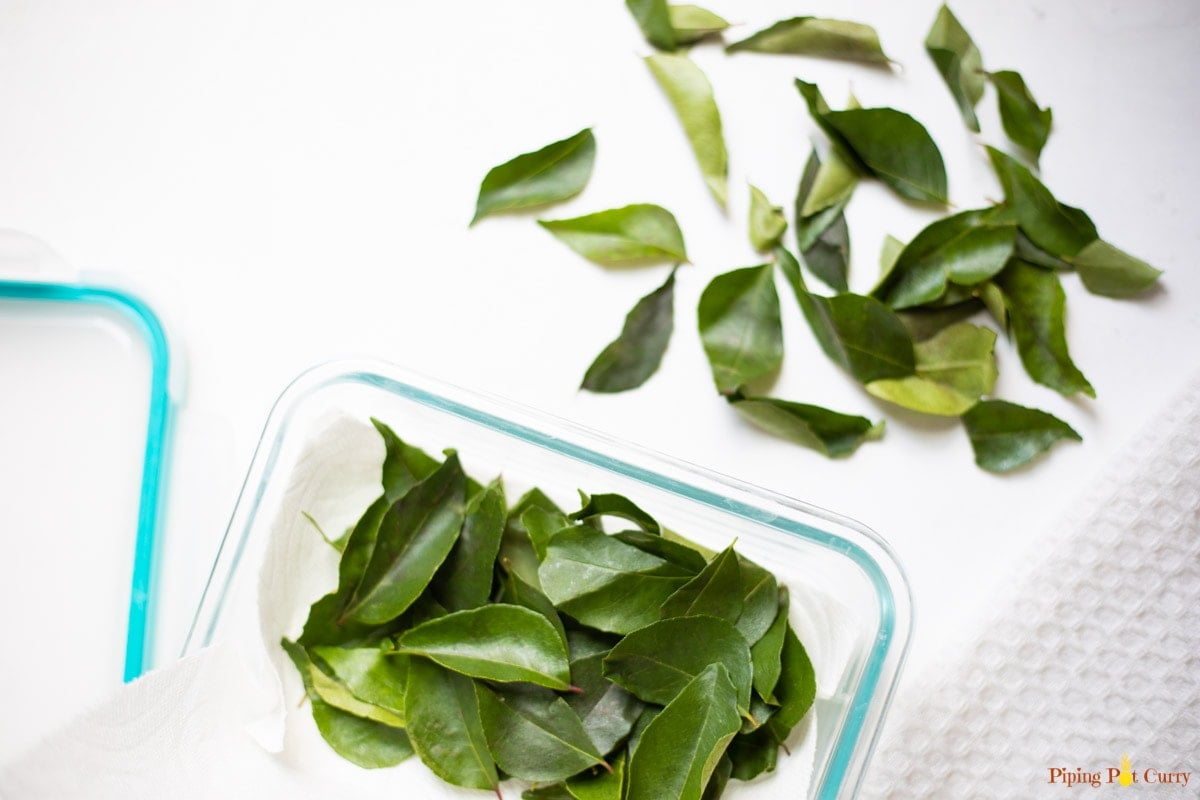
In the Freezer
You can store the leaves in a box or Ziploc bag in the freezer. The leaves may change color, but the taste remains the same. Whenever you need them, you can just take them out of the freezer and use them as is.

Dried Curry Leaves
If you have an abundance of curry leaves and don’t plan on using all of them within the time they are fresh, you can dry them- dried curry leaves stay good for 2-3 months!
Spread the curry leaves on a plate or baking tray. Let them air dry for 2-3 days on the counter or in the refrigerator. Once they are dried, they will look wilted and feel crispy. Now, these can be stored in an air-tight container or glass jar as is.

They can also be crumbled to a coarse or fine powder and then stored in a glass jar. Either way, you can use them in the same way you use fresh curry leaves.

I also enjoy adding these dried curry leaves to my tea sometimes. It instantly enhances the flavors & aromas. Fresh chai with curry leaves tastes so good!

Substitute for Curry Leaves
People will often try to find substitutes for curry leaves, but I personally feel there is no good substitute for them. So, if you can’t find them, it is totally fine to leave them out in a recipe.
Once again, curry powder and curry leaves are absolutely not the same and cannot be substituted!
Recipes Where I Use Curry Leaves
Curry leaves are used most in South Indian cooking, but you will find them used in Western and Northern Indian recipes as well.
Here are some recipes where I use them:
- Pongal
- Rava Dhokla
- Khaman Dhokla
- Peanut chutney
- Sambar
- Lemon Rice
- Vermicelli Upma
- Gujarati Dal
- Chicken Chettinad
- Bisi Bele Bath
I hope these tips & tricks help you in storing and using curry leaves. Try adding them to your favorite Indian recipes for wonderful, authentic flavors!
Happy Cooking!
More Cooking 101 posts
Cooking 101
How to Store Cilantro + Buy, Cut, & Use?
Cooking 101
How to make Garlic Paste?
Cooking 101
How to Buy and Store Ginger?

How to Store Curry Leaves
Ingredients
- Curry Leaves
Instructions
- Remove the curry leaves from the main stem.
- Wash the leaves and then dry them. Spread on a kitchen towel in a single layer and gently pat them dry before using one of the following methods for storage. You can also leave them on the kitchen towel to air dry.
Store in refrigerator
- Wrap the leaves in a paper towel and then put in an airtight container or mason jar. Then keep it in the fridge. Whenever you notice moisture droplets inside the container, wipe them away and change the paper towel, to ensure the leaves stay fresh for as long as possible.

Store in freezer
- Put the leaves into a box or Ziploc bag, and place it in the freezer. Whenever you want to use them, just take them out of the freezer and use as is.

Dried Curry Leaves
- Spread the leaves out on a plate or tray. Let them air dry for 2-3 days on the counter or in the refrigerator.

- Once they are dried, they will have a wilted appearance and feel crispy.

- You can keep them as is, or crumble them into a coarse or fine powder. Whether you prefer the leaves whole or crushed, store them in an airtight container or jar to preserve the flavor.




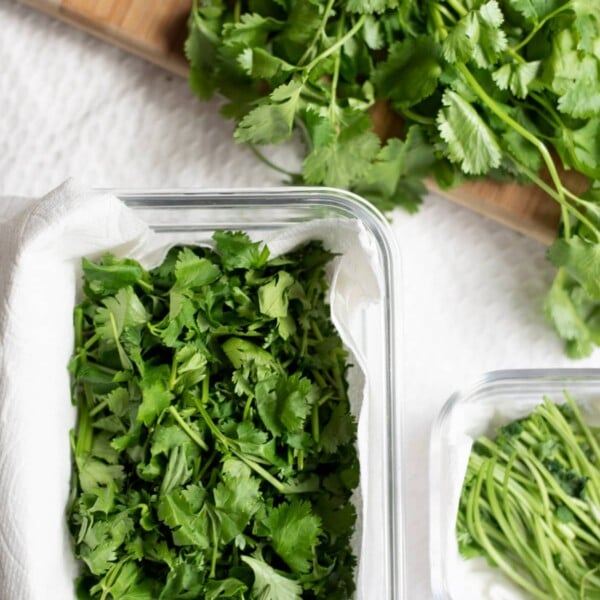



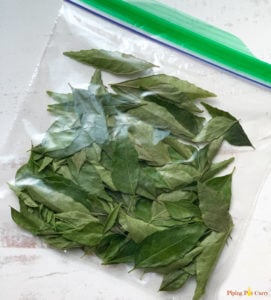

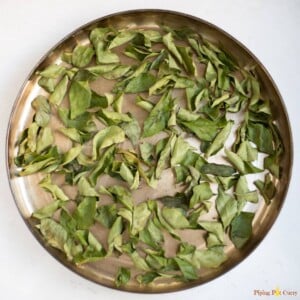
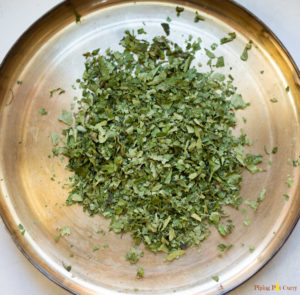












Your blog has become my ultimate source of inspiration for all things food! This recipe is a perfect example of why I keep coming back. The flavors and presentation are simply stunning. I appreciate how you include alternative ingredient suggestions for dietary preferences. It really shows your dedication to making your recipes accessible to all.
Just bought my first fresh curry leaves from a local store. Now I can recreate Malaysian Butter Chicken, which I absolutely loved when I lived there for a short time. Will be looking for other recipes for these delicious herbs too!
Hi Richard – Hope you enjoy the butter chicken.
Very informative; thanks for sharing. I learned a lot about Curry leaves. I love to use it in my kitchen, as well as for my health and haircare. Keep posting great stuff.
How many dried curry leaves would you put in a curry just for one person
Hi James – It would depend on the recipe, but go with 2-4 and then add more/less based on your preference.
They don’t like frost, so in colder climates they should be kept indoors in winter indeed. When you live in darker areas, or don’t have a window on the south, a grow light is highly recommended.
Hi I have a curry plant grows outside and is very big and healthy and extremely fragrant when moisten by sprinkler. But it is silvery colored and does not look at all like your green leaf plant… I live to breath in its fragrance but no idea what to do with it for cooking??? I love curry !
Hi Jenelle – Curry leaves have a wonderful fragrance. I have linked a few recipes where I use curry leaves in the post. Hope you give them a try!
Curry leaf and curry plant are not the same at all. Curry plant smells great but doesn’t have any culinary use…
Thanks so much for this article, should we store the dried curry leaves in fridge or can it be kept outside in an air tight container.
Hello – I keep the dried curry leaves outside in an airtight container. Glad you found the information helpful!
3 summers ago I purchased a $9 sprig of curry leaves from a woman who advertised on a website…..she had it in a very small pot which I transplanted…..I kept it outside as it was summer (Chicago)…..then brought inside when Fall weather began…..it began to fail….and by the following summer (2018) – i cut it down to nothing…..
Long long story short….I nursed that sprig back to life and have transplanted a couple times to the HUGE tree in my family room…it now stays inside all year long – enjoying its sunny exposure in front of a glass door.
It’s my pride and joy!
It is so good that you were able to keep the plant alive and are enjoying it.
Please forward a Photo/picture of the Curry leaves plant that you have grown indoors.
Hi Soloman – Sorry, I have not grown a plant indoors myself. However when I read about it, I see that people have grown a plant in the summer outdoors in good sunlight and brought it indoors during winter. Here is a post you might find helpful – https://www.justhomemade.net/tips-to-care-for-your-curry-leaf-plant-in-winter/